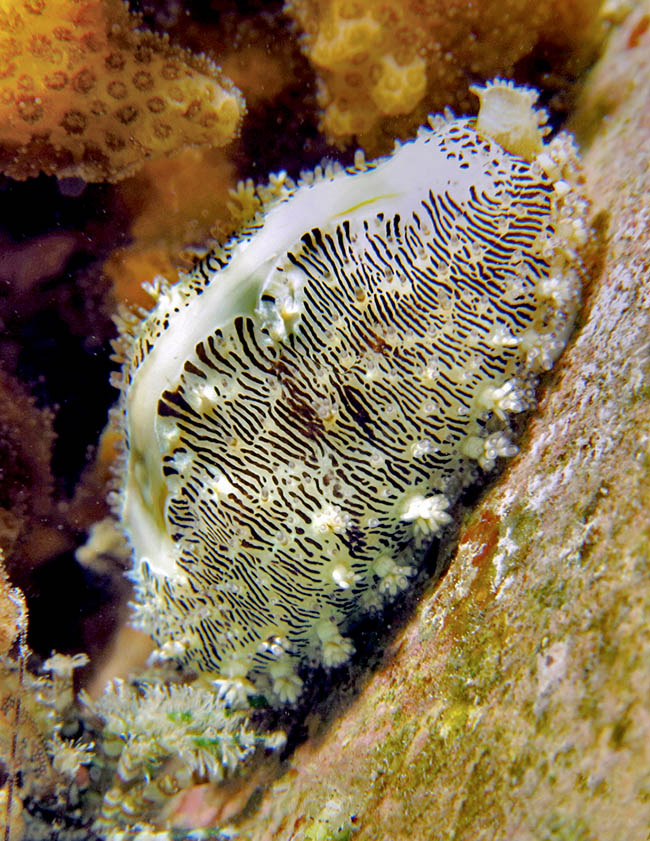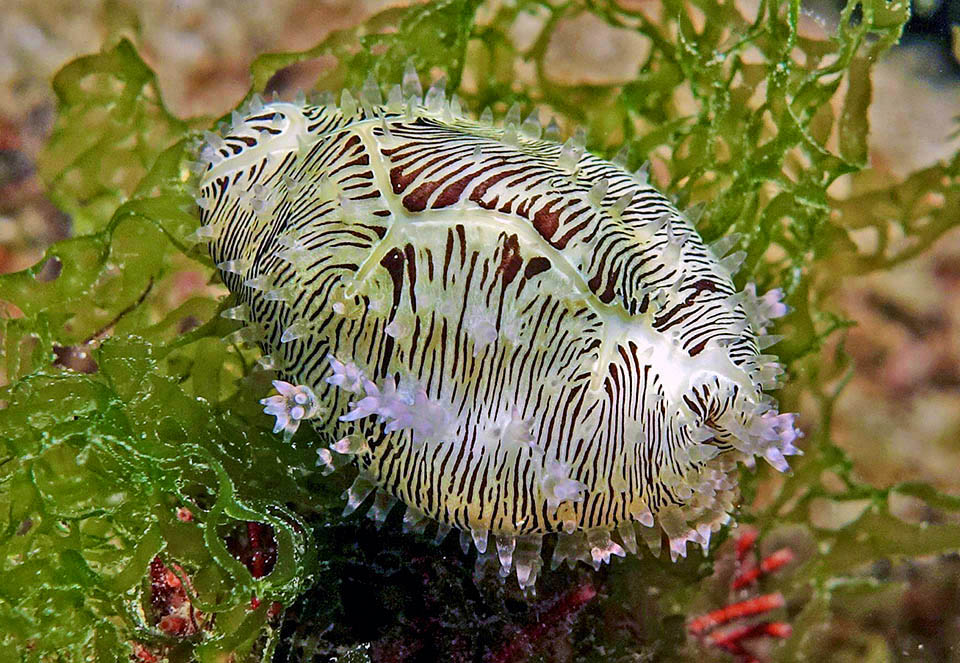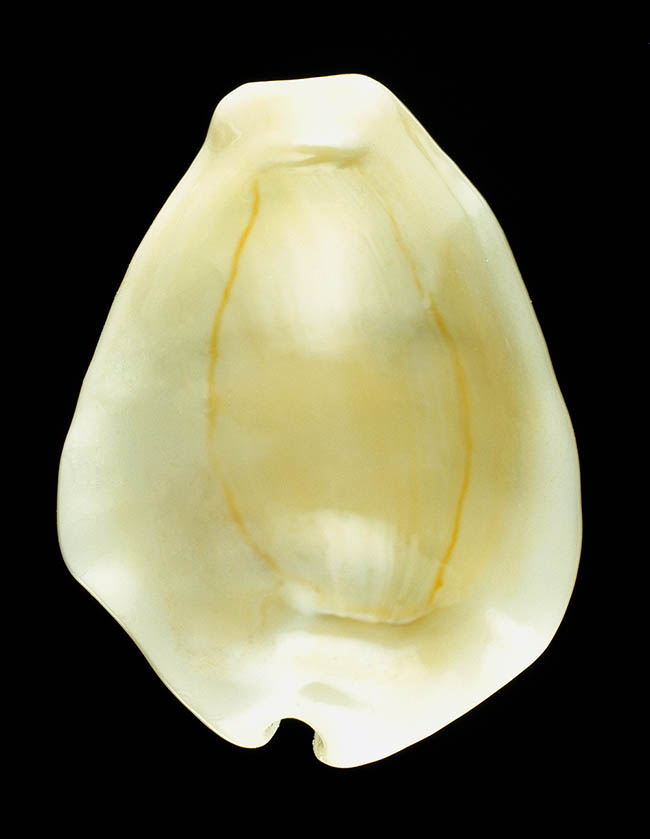Family : Cypraeidae

Text © Dr Domenico Pacifici

English translation by Mario Beltramini

Striking image of a moving Monetaria moneta with the siphon well visible on top © Pauline Walsh Jacobson
It is said that at the end of the thirteenth century Marco Polo, during his voyage in China, has noted how the natives did use “shells of porcelain and gold” during their commercial exchanges.
Obviously, it was not the gold that caught the attention of the famous explorer, but those so shiny and smooth small shells, ignoring that he was observing something that would change the history of man for the centuries to come.
The minute but big object of interest was nothing but a gastropod mollusk: its name is Monetaria moneta Linnaeus, 1758, and together with a cognate species, called Monetaria annulus, have been the first form of international currency in human history.
Called “cowry” shells, both belong to the family Cypraeidae, one of the better known and most complex in the world of marine gastropods, with more than 200 species and hundreds of subspecies to highlight the strong specialization of this group.
The original name was Cypraea moneta but the genus was changed in Monetaria around the mid 1800s, to include all the cowry shells used for commercial purposes.
Although it is intuitive how its Latin name comes entirely from the word “moneta”, less so is the meaning of the word itself: moneta comes in fact from the verb moneo, in the sense of warning, admonishing, thus referring to what should have done the goddess Juno if there was an imminent danger for Rome, and whose statue, rightly called “Moneta” was present inside the Roman mint.
Zoogeography
Monetaria moneta is a species strongly distributed in all tropical waters of the Indo-Pacific Ocean. It populates all the coasts of eastern and southern Africa passing by Madagascar, the Red Sea, eastern Polynesia and the Galapagos, from southern Japan up to Hawaiian coasts.
It seems that it is present also in the North Sea in the waters touching the coasts of the Netherlands, but the strong resemblance to the younger sister Monetaria annulus often originates sightings not always true.
Ecology-Habitat
This mollusk lives in the zone of the marine environment called mesolittoral (or intertidal), between the high and low tide levels. For such reasons this area may have an extension of a few decimetres or of many metres but usually Monetaria moneta does not go down beyond the 10 m of depth.

Here the mimetic mantle has covered the whole shell. The females show unusual parental care protecting the eggs until they hatch © Patrick Randall
To survive in this continuously changing environment, characterized by abrupt changes in salinity and temperature, Monetaria moneta takes shelter in the ponds forming when the water recedes at low tide, in the rocky areas with shallow waters and even among the remains of corals or of empty bivalves if the situation gets extreme.
It is a purely nocturnal animal that likes to graze the seaweeds growing on the surrounding rocks and fragments of dead coral, thanks to its spiny tongue called radula. Unluckily, despite its huge use as coin, little is still known about the ecological and feeding habits of this species.
Morphophysiology
Monetaria moneta is a small gastropod, with the shell that may reach a maximum length of 4,5 cm but it is more common to find it around 3 cm. The upper surface of the shell presents sooth and convex, of dirty white colour tending beige, flattened and irregular to form a sort of elongated hexagon with very callused backs, whilst the opening on the ventral part displays toothed surfaces typical to this group.

Like Monetaria annulus, the shell of this tropical Indo-Pacific species was yore used as coin © Giuseppe Mazza
The mantle is of creamy white colour with blackish brown zebra stripes and can be everted until completely covering the shell.
This structure is common also to other members of the same family and has a mimetic purpose as well as of environmental analysis as from the mantle depart multiple sensory papillae that carry on such function.
Unfortunately, due to the complex variety of forms this species is able to reach it is difficult to define a unique description valid for each specimen and it is not rare that during its cataloguing it is mistaken for a different species.
The radula, the spiny tongue used for grating food, is a very important parametre used for the classification of the gastropods and the placement of the teeth determines its different typology.
In the case of Monetaria moneta it is defined of tenioglossus type, characterized by a central tooth with a lateral one and two marginal per side.
Ethology-Reproductive biology
The individuals of this species have a well marked swual dimorphism, with the males presenting a size greater than that of the females.
The females spawn the eggs on hard surfaces and, unlike other gastropods, remain to protect them until they hatch.
This commitment in parental care is quite unusual for the sea gastropods and it is thought that it can be one of reasons for the success of this family of mollusks.
When the eggs are ripe they develop in planktonic larvae and later on in veliger, a larval form very common in the mollusks resulting among the most active organisms in the sea world.
Like its younger sister Monetaria annulus, also Monetaria moneta, despite the reckless abuse done by man for his commercial purposes, presently does not result endangered or on the verge of extinction.
Synonyms
Erosaria moneta Linnaeus, 1758; Cypraea moneta Linnaeus, 1758; Monetaria moneta moneta Linnaeus, 1758; Cypraea monetacongo Gmelin, 1791; Cypraea numisma Röding, 1798; Cypraea gibbosa Schröter, 1804; Cypraea icterina Lamarck, 1810; Monetaria moneta icterina Lamarck, 1810; Cypraea tuberculosa Quoy & Gaimard, 1834; Monetaria moneta tuberculosa Quoy & Gaimard, 1834; Cypraea barthelemyi Bernardi, 1861; Cypraea mercatorium Rochebrune, 1884; Monetaria vestimenti Rochebrune, 1884; Cypraea circumvallata M. Schilder & F. A. Schilder, 1933; Monetaria moneta subalata M. Schilder & F. A. Schilder, 1933; Cypraea annulifera Coen, 1949; Monetaria pseudomoneta C.-H. Hu, 1992; Monetaria moneta monetserpentis Lorenz, Chiapponi & Mont, 2012.
→ To appreciate the biodiversity within the MOLLUSCS please click here.
